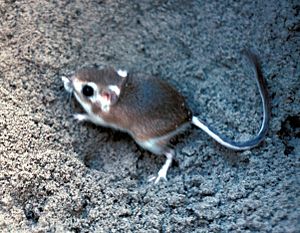Gulf Coast kangaroo rat facts for kids
Quick facts for kids Gulf Coast kangaroo rat |
|
|---|---|
 |
|
| Conservation status | |
| Scientific classification | |
| Genus: |
Dipodomys
|
| Species: |
compactus
|
The Gulf Coast kangaroo rat (Dipodomys compactus) is a small rodent that lives in Mexico and Texas in the United States. It belongs to the same family as other kangaroo rats. This rat looks and acts a lot like its close relative, Ord's kangaroo rat.
Contents
About the Gulf Coast Kangaroo Rat
Adult Gulf Coast kangaroo rats are about 22 centimeters (9 inches) long. This measurement includes their long tail, which is about 12 centimeters (5 inches).
These rats can have two main colors. Some are a dusty gray, while others are a reddish or yellowish-brown. Their sides and flanks show the clearest color. The fur on their backs has dark tips, making it look a bit blackish. They have white cheeks, and their ears are brown. The top and bottom of their tails also have brown stripes.
This type of kangaroo rat is usually lighter in color than other kangaroo rats. You can tell it apart from the Ord's kangaroo rat by its shorter tail. Its tail also does not have a crest, and its fur is shorter and rougher.
Where They Live
The Gulf Coast kangaroo rat lives in southeastern Texas. You can find them south of Bexar and Gonzales counties. They also live in Zapata County, Mustang Island, and Padre Island. These islands are just off the coast of Texas. They are also found on the barrier islands off the state of Tamaulipas in Mexico.
Their Home and Food
The Gulf Coast kangaroo rat is mostly active at night. It eats seeds, which it gathers in special pouches in its cheeks. It then carries these seeds back to its burrow to store them.
These rats like to live in sandy areas with not many plants. They often live among sand dunes, usually on the side of a dune that is protected from the wind.
Some plants found where they live include sea oats (Uniola paniculata) and bluestem grass (Andropogon). You might also see saltgrass (Distichlis), fringe-rushes (Fimbristylis), sunflowers (Helianthus), and croton (Croton). In some parts of Texas, they live in mesquite areas. Here, they are found with wiregrasses (Aristida), hairy grama (Bouteloua hirsuta), and hooded windmill grass (Chloris cucullata). Prickly pear (Opuntia) cactus is also common in these areas.
Conservation Status
The number of Gulf Coast kangaroo rats seems to be stable. No major threats have been found for them. They are quite common in places where they can live. Because of this, the IUCN has listed them as being of "least concern". This means they are not currently in danger of disappearing.
See also
 In Spanish: Dipodomys compactus para niños
In Spanish: Dipodomys compactus para niños


